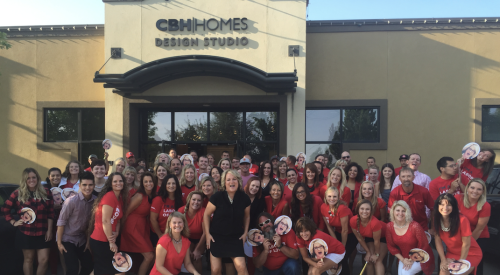|
In an era when some of the biggest home building companies are consolidating, the founders of one privately owned company made a very different decision. After 35 years, Tom and Caroline Hoyt are transferring ownership of McStain Neighborhoods, No. 201 on the 2001 Giants list, to the people who most passionately share their vision — their 100 employees.
Since 1968, the Hoyts have been the primary shareholders of Boulder, Colo.-based McStain, a company committed to creating sustainable communities and homes. Although the decision was not easy, keeping the company private and creating an employee stock option plan (ESOP) seemed like the most sustainable option for the company’s long-term success.
Tom Hoyt says that after surviving the recession of the late 1980s and early ’90s, when permits in the Denver-Boulder area dropped from 18,911 in 1986 to 5,956 in 1990, the Hoyts knew they had to start thinking about succession plans. He says there were not a lot of choices, and he feared that the obvious one — selling to a larger company — might mean compromising the company’s mission and values. “It’s extremely difficult to have a long-term vision within a public firm where you’re measured by quarterly results,” says Hoyt.
“The ESOP was born out of our mission and of people committed to what they were doing,” Hoyt says. That mission, “building a better world,” is threefold. It revolves around designing and building visionary communities that meet the needs of customers, building a sustainable partnership with the natural environment, and treating clients, employees, associates and the broader community with respect and integrity. “The people side of this is very intentional and has to be,” Hoyt says.
Implemented Jan. 1, 2001, the McStain ESOP is different from most ESOPs in that shares are given to all employees at no cost to them. The plan is not optional, and employees do not have to sign up to participate — once an employee has worked at least 1,000 hours in a calendar year, he or she automatically starts on the plan. A fixed amount of profit, about 8.3% of each employee’s salary, is contributed to the individual’s account, and employees are fully vested when they have been with McStain for six years. (Most employees cannot contribute to the account, but certain members of the management team may buy stock.) When vested employees leave or retire, the McStain ESOP trust buys the employees’ shares for fair market value.
Computer models of employee attrition, turnover rates (which at 22% through November 2001 were below the industry average for the year) and lots of worst-case and best-case scenarios helped the Hoyts assess their personal risks and responsibilities and work out the details of their ESOP.
“What you try to do in an ESOP is make ownership real and tangible enough to employees so they’ll start to feel like owners and balance that with normal attrition,” says Ann Stringfellow, McStain’s vice president of ecology and director of human resources. “You have to understand cash flow and be really careful to walk that line between making it tangible and preserving a protective stance for the company.”
To achieve the tangible side of that balance, McStain constantly reinforces the ESOP as being part of a four-legged stool — compensation, benefits, incentive compensation package (formerly profit sharing) and the ESOP — in hopes of maintaining a “culture of mutual investment,” Stringfellow says. The ESOP was introduced at a quarterly town meeting just before its roll-out, and Stringfellow says that how it works is revisited, along with McStain’s other benefits, during a Benefits Brainteaser game at each quarterly meeting.
| “It’s extremely difficult to have a long-term vision within a public firm where you’re measured by quarterly results.” |
At departmental meetings last month, each employee received a tailored benefits statement including the amount of vested stock he or she owns. That was followed by an outreach session where employees could ask human resources personnel about the stock.
Fran Sullivan, a financial analyst who has worked for McStain for seven years, says most of the employees she talked to seemed to understand their first ESOP statements. “I think it will take some people some time to get used to it because it’s vested at 20% a year,” says Sullivan. “That’s six years before we’re vested, and there are some people who will be cranky about that.
“It gives me a larger sense of commitment. I’m a year into it, and if I walk away now, I’m walking away from an investment — and it’s not just a token, it’s meaningful. It’s another way McStain, and the Hoyts in particular, are trying to foster the idea that we have our day-to-day working lives but we also have some sense of long-term accomplishment and ownership.”
Stringfellow agrees that employees are starting to recognize how their individual and departmental goals are directly tied to those of the company, and that they can affect the bottom line. “They’re starting to think like owners,” she says.
It’s not clear how many other home builders have ESOPs in which the company contributes shares of stock to all employees at no cost to them, but only three home builders are registered with the ESOP Association (McStain is not one of them).
The transfer of control from the Hoyts to the McStain ESOP trust probably will be complete in about 10 years, Tom Hoyt says. McStain has hired Eric Whittenberg (pictured), who has worked with California home building companies, both public and private, for more than 20 years, as president and chief operating officer. He will take over as CEO in a year.
And what will the Hoyts be up to? “I don’t think you could get Caroline off the drawing board,” Tom Hoyt says of his architect wife. He plans to spend a lot of time working with nonprofit groups such as The Nature Conservancy, for which he is a state board member and lifetime member. To help with those efforts, McStain employees recently surprised the couple by announcing the formation of The Hoyt Foundation for Building a Better World, the company’s new charitable extension.












